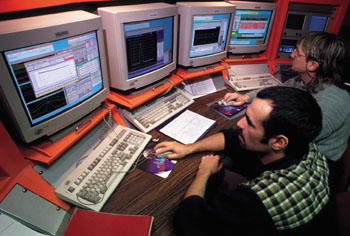Software is playing an increasingly important role in the tricky business of setting up the beams from particle accelerators. A recent workshop at CERN looked at what has been accomplished so far and what still needs to be done.

The aim of the ABS Automated Beam Steering project is to give accelerator operators a set of software tools to make their lives easier, while improving the quality of the beams that they deliver. The scheme was initiated by Bruno Autin in CERN’s Proton Synchrotron (PS) Division. Similar projects are in place in accelerator labs around the world, and on 14-16 December CERN hosted a workshop for 70 accelerator physicists. On the agenda was software sharing to make best use of limited resources, the adoption of a common vocabulary and a look ahead to control systems for future accelerators.
When accelerator physics was young, particle accelerators were set up by hand. Operators would go to the magnets with a voltmeter and a screwdriver and adjust each one. Now, computers display information and allow the magnet-tweaking to be done from a central control room, but the procedure is essentially still manual.
With modern computer technology it was only a matter of time before someone asked if operators are necessary. Could accelerators be controlled by computer? The answer, at least for now, is no. Skilled operators are still needed to ensure the smooth running of these sensitive machines, and so the ABS project was born. After two years of preparation, prototypes written by the PS controls group were tested last year and the new tools will be available in 1999.
ABS is not the first attempt at the partial automation of accelerator controls. The project’s origin can be traced to the antiproton source control software designed by CERN’s 1984 Nobel laureate Simon van der Meer. Later, at CERN’s LEP electronpositron collider, an ABS-type program was written to perform closed-orbit corrections. ABS is, however, the first standardized set of software tools for the purpose. Previous attempts in PS have not been successful because, without a standard interface to the software, operators simply found it easier to continue as they were, rather then learn a new system for each kind of accelerator adjustment. The ABS team’s main feature is a generic interface, so whatever adjustment is needed, the program to do it looks the same to the operator.
The ABS backbone is an Oracle database in which every detail of the accelerator can be described. One problem faced by the venerable PS when the project began is that, without a database, vital information was being lost as people retired. Oracle expert Josi Schinzel joined PS in early 1997 to address this problem and has designed a flexible database package that can be adapted easily to new kinds of data as required. Currently it includes all of the information needed to control the accelerator in day-to-day running. In the future it will be extended to include more general documentation of the type frequently carried around only inside experts’ heads.
The ABS procedure starts by setting up the accelerator to nominal settings. But, at PS, those settings were defined in the 1950s and were badly dated. So, when the ABS project began, even this step had to be redefined. Over the years, parts had moved and new ones had been added, so the first step was to dust off the old nominal model and update it, realigning components that had not been touched since they were installed in the 1950s. However, even the best model is never exact. There are always uncertainties in magnet currents, ground movements are not accounted for, and there are inevitably magnetic inhomogeneities. To optimize, the machine parameters must be tweaked until the beam is as required.
ABS uses the Mathematica package along with minimization software developed at CERN. Dedicated corrector magnets dipoles or quadrupoles are then tweaked by the program to produce an optimal beam. In the PS, 40 corrector magnets are under ABS control for closed-orbit corrections alone. Not all are needed to make a correction. For an operator to go through all of the permutations to find the optimal solution would take weeks. ABS can do the job in minutes, thus reducing the arbitrariness of the process.
December’s workshop was the first of its kind but is unlikely to be the last. Already, accelerator physicists from SLAC are planning a follow-up in two years’ time. About half of the workshop’s participants were from CERN; the rest came from accelerator labs around the world, with all of the main particle physics sites being represented.
Summing up the meeting, CERN’s Phil Bryant stressed the chance for industry to play a role, citing the ABS system in use at Italy’s ELETTRA synchrotron light source as an ideal candidate for a commercial package. This would be a godsend for small labs where resources to develop the software themselves are not available.
ABS is currently applied to the PS, Booster and several associated linacs and transfer lines. At CERN’s December workshop, accelerator physicists began sharing their expertise in a bid to extend ABS and similar systems to other accelerator complexes. The net result will be better beams for researchers and a quieter life for operators.








